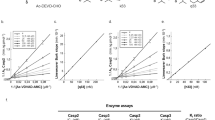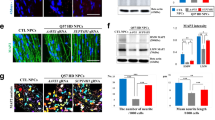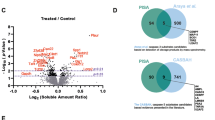Abstract
Huntington's disease (HD) is an autosomal dominant progressive neurodegenerative disorder resulting in selective neuronal loss and dysfunction in the striatum and cortex. The molecular pathways leading to the selectivity of neuronal cell death in HD are poorly understood. Proteolytic processing of full-length mutant huntingtin (Htt) and subsequent events may play an important role in the selective neuronal cell death found in this disease. Despite the identification of Htt as a substrate for caspases, it is not known which caspase(s) cleaves Htt in vivo or whether regional expression of caspases contribute to selective neuronal cells loss. Here, we evaluate whether specific caspases are involved in cell death induced by mutant Htt and if this correlates with our recent finding that Htt is cleaved in vivo at the caspase consensus site 552. We find that caspase-2 cleaves Htt selectively at amino acid 552. Further, Htt recruits caspase-2 into an apoptosome-like complex. Binding of caspase-2 to Htt is polyglutamine repeat-length dependent, and therefore may serve as a critical initiation step in HD cell death. This hypothesis is supported by the requirement of caspase-2 for the death of mouse primary striatal cells derived from HD transgenic mice expressing full-length Htt (YAC72). Expression of catalytically inactive (dominant-negative) forms of caspase-2, caspase-7, and to some extent caspase-6, reduced the cell death of YAC72 primary striatal cells, while the catalytically inactive forms of caspase-3, -8, and -9 did not. Histological analysis of post-mortem human brain tissue and YAC72 mice revealed activation of caspases and enhanced caspase-2 immunoreactivity in medium spiny neurons of the striatum and the cortical projection neurons when compared to controls. Further, upregulation of caspase-2 correlates directly with decreased levels of brain-derived neurotrophic factor in the cortex and striatum of 3-month YAC72 transgenic mice and therefore suggests that these changes are early events in HD pathogenesis. These data support the involvement of caspase-2 in the selective neuronal cell death associated with HD in the striatum and cortex.
Similar content being viewed by others
Log in or create a free account to read this content
Gain free access to this article, as well as selected content from this journal and more on nature.com
or
Abbreviations
- HD:
-
Huntington's disease
- Htt:
-
huntingtin
- BDNF:
-
brain-derived neurotrophic factor
- GFP:
-
green fluorescent protein
- TUNEL:
-
terminal deoxynucleotidyl transferase-mediated dUTP nick-end labeling
- PVDF:
-
polyvinylidene fluoride
- GFAP:
-
glial fibrillary acidic protein
References
The Huntington's Disease Collaborative Research Group. (1993) A novel gene containing a trinucleotide repeat that is expanded and unstable on Huntington's disease chromosomes. Cell 72: 971–983
Imbert G, Saudou F, Yvert G, Devys D, Trottier Y, Garnier JM, Weber C, Mandel JL, Cancel G, Abbas N, Durr A, Didierjean O, Stevanin G, Agid Y and Brice A (1996) Cloning of the gene for spinocerebellar ataxia 2 reveals a locus with high sensitivity to expanded CAG/glutamine repeats. Nat. Genet. 14: 285–291
Kawaguchi Y, Okamoto T, Taniwaki M, Aizawa M, Inoue M, Katayama S, Kawakami H, Nakamura S, Nishimura M, Akiguchi I, Kimura J, Narumiya S and Kakizuka A (1994) CAG expansions in a novel gene for Machado–Joseph disease at chromosome 14q32.1. Nat. Genet. 8: 221–228
Koide R, Ikeuchi T, Onodera O, Tanaka H, Igarashi S, Endo K, Takahashi H, Kondo R, Ishikawa A, Hayashi T, Saito M, Tomoda A, Miike T, Naito H, Ikuta F and Tsuji S (1994) Unstable expansion of CAG repeat in hereditary dentatorubral-pallidoluysian atrophy (DRPLA). Nat. Genet. 6: 9–13
La Spada AR, Wilson EM, Lubahn DB, Harding AE and Fischbeck KH (1991) Androgen receptor gene mutations in X-linked spinal and bulbar muscular atrophy. Nature 352: 77–79
Lindblad K, Savontaus ML, Stevanin G, Holmberg M, Digre K, Zander C, Ehrsson H, David G, Benomar A, Nikoskelainen E, Trottier Y, Holmgren G, Ptacek LJ, Anttinen A, Brice A and Schalling M (1996) An expanded CAG repeat sequence in spinocerebellar ataxia type 7. Genome Res. 6: 965–971
Nagafuchi S, Yanagisawa H, Sato K, Shirayama T, Ohsaki E, Bundo M, Takeda T, Tadokoro K, Kondo I, Murayama N, Tanaka Y, Kikushima H, Unino K, Kurosawa H, Furukawa T, Nihei K, Inouc T, Sano A, Komure O, Takahashi M, Yoshizawa T, Kanazawa I and Yamada M (1994) Dentatorubral and pallidoluysian atrophy expansion of an unstable CAG trinucleotide on chromosome 12p. Nat. Genet. 6: 14–18
Orr HT, Chung MY, Banfi S, Kwiatkowski Jr TJ, Servadio A, Beaudet AL, McCall AE, Duvick LA, Ranum LP and Zoghbi HY (1993) Expansion of an unstable trinucleotide CAG repeat in spinocerebellar ataxia type 1. Nat. Genet. 4: 221–226
Pulst SM, Nechiporuk A, Nechiporuk T, Gispert S, Chen XN, Lopes-Cendes I, Pearlman S, Starkman S, Orozco-Diaz G, Lunkes A, DeJong P, Rouleau GA, Auburger G, Korenberg JR, Figueroa C and Sahba S (1996) Moderate expansion of a normally biallelic trinucleotide repeat in spinocerebellar ataxia type 2. Nat. Genet. 14: 269–276
Sanpei K, Takano H, Igarashi S, Sato T, Oyake M, Sasaki H, Wakisaka A, Tashiro K, Ishida Y, Ikeuchi T, Koide R, Saito M, Sato A, Tanaka T, Hanyu S, Takiyama Y, Nishizawa M, Shimizu N, Nomura Y, Segawa M, Iwabuchi K, Eguchi I, Tanaka H, Takahashi H and Tsuji S (1996) Identification of the spinocerebellar ataxia type 2 gene using a direct identification of repeat expansion and cloning technique, DIRECT. Nat. Genet. 14: 277–284
Zhuchenko O, Bailey J, Bonnen P, Ashizawa T, Stockton DW, Amos C, Dobyns WB, Subramony SH, Zoghbi HY and Lee CC (1997) Autosomal dominant cerebellar ataxia (SCA6) associated with small polyglutamine expansions in the alpha 1A-voltage-dependent calcium channel. Nat. Genet. 15: 62–69
Ross CA (1995) When more is less: pathogenesis of glutamine repeat neurodegenerative diseases. Neuron 15: 493–496
Martin JB and Gusella JF (1986) Huntington's disease. Pathogenesis and management. N. Engl. J. Med. 315: 1267–1276
Hedreen JC and Folstein SE (1995) Early loss of neostriatal striosome neurons in Huntington's disease. J. Neuropathol. Exp. Neurol. 54: 105–120
Vonsattel JP, Myers RH, Stevens TJ, Ferrante RJ, Bird ED and Richardson Jr EP (1985) Neuropathological classification of Huntington's disease. J. Neuropathol. Exp. Neurol. 44: 559–577
Gutekunst CA, Levey AI, Heilman CJ, Whaley WL, Yi H, Nash NR, Rees HD, Madden JJ and Hersch SM (1995) Identification and localization of huntingtin in brain and human lymphoblastoid cell lines with anti-fusion protein antibodies. Proc. Natl. Acad. Sci. USA 92: 8710–8714
Sharp AH, Love SJ, Schilling G, Li SH, Li XJ, Bao J, Wagster MV, Kotzuk JA, Steiner JP, Lo A, Hedreen J, Sisodia S, Snyder SH, Dawson TM, Ryugo DK and Ross CA (1995) Widespread expression of Huntington's disease gene (IT15) protein product. Neuron 14: 1065–1074
Trottier Y, Lutz Y, Stevanin G, Imbert G, Devys D, Cancel G, Saudou F, Weber C, David G, Tora L, Agid Y, Brice A and Mandel J (1995) Polyglutamine expansion as a pathological epitope in Huntington's disease and four dominant cerebellar ataxias. Nature 378: 403–406
De Rooij KE, Dorsman JC, Smoor MA, Den Dunnen JT and Van Ommen GJ (1996) Subcellular localization of the Huntington's disease gene product in cell lines by immunofluorescence and biochemical subcellular fractionation. Hum. Mol. Genet. 5: 1093–1099
DiFiglia M, Sapp E, Chase K, Schwarz C, Meloni A, Young C, Martin E, Vonsattel JP, Carraway R, Reeves SA, Boyce FM and Aronin N (1995) Huntingtin is a cytoplasmic protein associated with vesicles in human and rat brain neurons. Neuron. 14: 1075–1081
Saudou F, Devys D, Trottier Y, Imbert G, Stoeckel ME, Brice A and Mandel JL (1996) Polyglutamine expansions and neurodegenerative diseases. Cold Spring Harb. Symp. Quant. Biol. 61: 639–647
Graveland GA, Williams RS and DiFiglia M (1985) Evidence for degenerative and regenerative changes in neostriatal spiny neurons in Huntington's disease. Science 227: 770–773
Reiner A, Albin RL, Anderson KD, D'Amato CJ, Penney JB and Young AB (1988) Differential loss of striatal projection neurons in Huntington disease. Proc. Natl. Acad. Sci. USA 85: 5733–5737
Sapp E, Ge P, Aizawa H, Bird E, Penney J, Young AB, Vonsattel JP and DiFiglia M (1995) Evidence for a preferential loss of enkephalin immunoreactivity in the external globus pallidus in low grade Huntington's disease using high resolution image analysis. Neuroscience 64: 397–404
Portera-Cailliau C, Hedreen JC, Price DL and Koliatsos VE (1995) Evidence for apoptotic cell death in Huntington disease and excitotoxic animal models. J. Neurosci. 15: 3775–3787
Ellerby LM, Andrusiak RL, Wellington CL, Hackam AS, Propp SS, Wood JD, Sharp AH, Margolis RL, Ross CA, Salvesen GS, Hayden MR and Bredesen DE (1999) Cleavage of atrophin-1 at caspase site aspartic acid 109 modulates cytotoxicity. J. Biol. Chem. 274: 8730–8736
Ellerby LM, Hackam AS, Propp SS, Ellerby HM, Rabizadeh S, Cashman NR, Trifiro MA, Pinsky L, Wellington CL, Salvesen GS, Hayden MR and Bredesen DE (1999) Kennedy's disease: caspase cleavage of the androgen receptor is a crucial event in cytotoxicity. J. Neurochem. 72: 185–195
Goldberg YP, Nicholson DW, Rasper DM, Kalchman MA, Koide HB, Graham RK, Bromm M, Kazemi-Esfarjani P, Thornberry NA, Vaillancourt JP and Hayden MR (1996) Cleavage of huntingtin by apopain, a proapoptotic cysteine protease, is modulated by the polyglutamine tract. Nat. Genet. 13: 442–449
Wellington CL, Ellerby LM, Hackam AS, Margolis RL, Trifiro MA, Singaraja R, McCutcheon K, Salvesen GS, Propp SS, Bromm M, Rowland KJ, Zhang T, Rasper D, Roy S, Thornberry N, Pinsky L, Kakizuka A, Ross CA, Nicholson DW, Bredesen DE and Hayden MR (1998) Caspase cleavage of gene products associated with triplet expansion disorders generates truncated fragments containing the polyglutamine tract. J. Biol. Chem. 273: 9158–9167
Hodgson JG, Agopyan N, Gutekunst CA, Leavitt BR, LePiane F, Singaraja R, Smith DJ, Bissada N, McCutcheon K, Nasir J, Jamot L, Li XJ, Stevens ME, Rosemond E, Roder JC, Phillips AG, Rubin EM, Hersch SM and Hayden MR (1999) A YAC mouse model for Huntington's disease with full-length mutant huntingtin, cytoplasmic toxicity, and selective striatal neurodegeneration. Neuron 23: 181–192
Wellington CL, Ellerby LM, Gutekunst CA, Rogers D, Warby S, Graham RK, Loubser O, van Raamsdonk J, Singaraja R, Yang YZ, Gafni J, Bredesen D, Hersch SM, Leavitt BR, Roy S, Nicholson DW and Hayden MR (2002) Caspase cleavage of mutant huntingtin precedes neurodegeneration in Huntington's disease. J. Neurosci. 22: 7862–7872
Gafni J and Ellerby LM (2002) Calpain activation in Huntington's disease. J. Neurosci. 22: 4842–4849
Zuccato C, Ciammola A, Rigamonti D, Leavitt BR, Goffredo D, Conti L, MacDonald ME, Friedlander RM, Silani V, Hayden MR, Timmusk T, Sipione S and Cattaneo E (2001) Loss of huntingtin-mediated BDNF gene transcription in Huntington's disease. Science 293: 493–498
Hackam AS, Singaraja R, Wellington CL, Metzler M, McCutcheon K, Zhang T, Kalchman M and Hayden MR (1998) The influence of huntingtin protein size on nuclear localization and cellular toxicity. J. Cell Biol. 141: 1097–1105
Martindale D, Hackam A, Wieczorek A, Ellerby L, Wellington C, McCutcheon K, Singaraja R, Kazemi-Esfarjani P, Devon R, Kim SU, Bredesen DE, Tufaro F and Hayden MR (1998) Length of huntingtin and its polyglutamine tract influences localization and frequency of intracellular aggregates. Nat. Genet. 18: 150–154
Wellington CL, Singaraja R, Ellerby L, Savill J, Roy S, Leavitt B, Cattaneo E, Hackam A, Sharp A, Thornberry N, Nicholson DW, Bredesen DE and Hayden MR (2000) Inhibiting caspase cleavage of huntingtin reduces toxicity and aggregate formation in neuronal and nonneuronal cells. J. Biol. Chem. 275: 19831–19838
Troy CM, Rabacchi SA, Hohl JB, Angelastro JM, Greene LA and Shelanski ML (2001) Death in the balance: alternative participation of the caspase-2 and -9 pathways in neuronal death induced by nerve growth factor deprivation. J. Neurosci. 21: 5007–5016
Sanchez I, Xu CJ, Juo P, Kakizaka A, Blenis J and Yuan J (1999) Caspase-8 is required for cell death induced by expanded polyglutamine repeats. Neuron. 22: 623–633
Krajewski S, Krajewska M, Ellerby LM, Welsh K, Xie Z, Deveraux QL, Salvesen GS, Bredesen DE, Rosenthal RE, Fiskum G and Reed JC (1999) Release of caspase-9 from mitochondria during neuronal apoptosis and cerebral ischemia. Proc. Natl. Acad. Sci. USA 96: 5752–5757
Mancini M, Machamer CE, Roy S, Nicholson DW, Thornberry NA, Casciola-Rosen LA and Rosen A (2000) Caspase-2 is localized at the Golgi complex and cleaves golgin-160 during apoptosis. J. Cell Biol. 149: 603–612
Rao RV, Peel A, Logvinova A, del Rio G, Hermel E, Yokota T, Goldsmith PC, Ellerby LM, Ellerby HM and Bredesen DE (2002) Coupling endoplasmic reticulum stress to the cell death program: role of the ER chaperone GRP78. FEBS Lett. 514: 122–128
Yaoita Y (2002) Inhibition of nuclear transport of caspase-7 by its prodomain. Biochem. Biophys. Res. Commun. 291: 79–84
Miyashita T, Matsui J, Ohtsuka Y, Mami U, Fujishima S, Okamura-Oho Y, Inoue T and Yamada M (1999) Expression of extended polyglutamine sequentially activates initiator and effector caspases. Biochem. Biophys. Res. Commun. 257: 724–730
Li H, Li SH, Johnston H, Shelbourne PF and Li XJ (2000) Amino-terminal fragments of mutant huntingtin show selective accumulation in striatal neurons and synaptic toxicity. Nat. Genet. 25: 385–389
Slow EJ, Van Raamsdonk J, Rogers D, Coleman SH, Graham RK, Deng Y, Oh R, Bissada N, Hossain SM, Yang YZ, Li XJ, Simpson EM, Gutekunst CA, Leavitt BR and Hayden MR (2003) Selective striatal neuronal loss in a YAC128 mouse model of Huntington disease. Hum. Mol. Genet. 12: 1555–1567
Mende-Mueller LM, Toneff T, Hwang SR, Chesselet MF and Hook VY (2001) Tissue-specific proteolysis of Huntingtin (htt) in human brain: evidence of enhanced levels of N- and C-terminal htt fragments in Huntington's disease striatum. J. Neurosci. 21: 1830–1837
Saudou F, Finkbeiner S, Devys D and Greenberg ME (1998) Huntingtin acts in the nucleus to induce apoptosis but death does not correlate with the formation of intranuclear inclusions. Cell 95: 55–66
Acknowledgements
LME is supported by National Institutes of Health Grant NS40251A, Huntington Disease Society of America, Hereditary Disease Foundation and the Muscular Dystrophy Association. JG is supported by a National Institutes of Health postdoctoral fellowship F32 NS043937. CW and AP are supported by Hereditary Disease Foundation Postdoctoral Fellowships. ASH is supported by MRC Canada. DB is supported by grants from the National Institutes of Health (AG12282 and CA69381). MRH is supported by Merck Frosst grants to the CMMT. MRH is also supported by the Medical Research Council of Canada, the Canadian Networks of Centres of Excellence (NCE-Genetics), and the Huntington Disease Society of America, Coalition for the Cure, and is an established investigator of the BC Children's Hospital. The tissues were provided by the Harvard Brain Tissue Resource Center that is supported in part by PHS grant number MN/NS 31862. We gratefully acknowledge Donald Nicholson and Sophie Roy for generously sharing the Htt neoepitopea antibodies for this project.
Author information
Authors and Affiliations
Corresponding author
Additional information
Edited by Dr P Nicotera
Rights and permissions
About this article
Cite this article
Hermel, E., Gafni, J., Propp, S. et al. Specific caspase interactions and amplification are involved in selective neuronal vulnerability in Huntington's disease. Cell Death Differ 11, 424–438 (2004). https://doi.org/10.1038/sj.cdd.4401358
Received:
Revised:
Accepted:
Published:
Issue date:
DOI: https://doi.org/10.1038/sj.cdd.4401358
Keywords
This article is cited by
-
Microfluidic deep mutational scanning of the human executioner caspases reveals differences in structure and regulation
Cell Death Discovery (2022)
-
A soluble truncated tau species related to cognitive dysfunction and caspase-2 is elevated in the brain of Huntington’s disease patients
Acta Neuropathologica Communications (2019)
-
Metalloproteinases and their tissue inhibitors in Alzheimer’s disease and other neurodegenerative disorders
Cellular and Molecular Life Sciences (2019)
-
Differential susceptibility of striatal, hippocampal and cortical neurons to Caspase-6
Cell Death & Differentiation (2018)
-
Huntington Disease as a Neurodevelopmental Disorder and Early Signs of the Disease in Stem Cells
Molecular Neurobiology (2018)



